 Facebook
Facebook
 X
X
 Instagram
Instagram
 TikTok
TikTok
 Youtube
Youtube
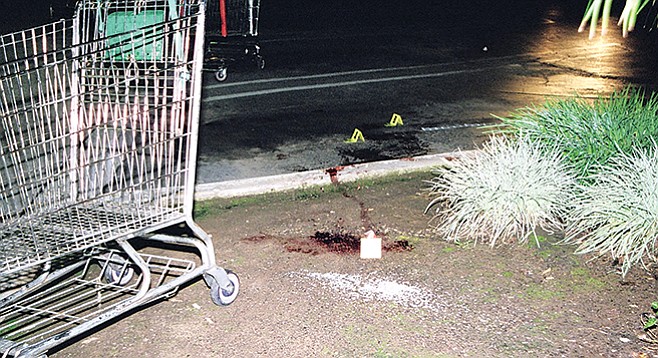
The bloodstains have long since faded, courtesy of Scram, sun, and time. More than a decade ago, in the parking lot of a Vons in Santee, Christopher St. Louis, 18, lost his life in the pursuit of free beer, shot by off-duty El Cajon police officer Tenaya Webb.
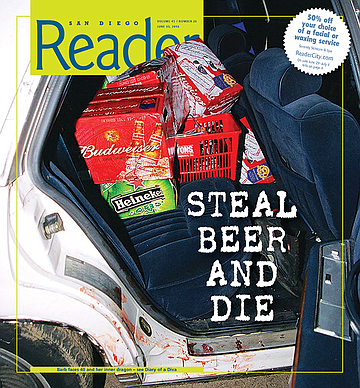
On February 16, 2003, a Sunday evening, St. Louis and three buddies were out on a “beer run” when they ran into Webb. According to homicide investigator Lt. Terry Wisniewski, Webb had been shopping when she saw the teens loading cases of beer from a shopping cart into a car. Notwithstanding her off-duty status, and apparently surmising that St. Louis and the others were stealing the beer (misdemeanor shoplifting), Webb ordered the youths to “put the beer back,” after which they’d ostensibly be free to go.
What happened next will sound familiar to anyone scanning the news these days: shots fired, a young man dead, and a police officer placed on paid administrative leave. But the story line deviated at this juncture, because there was no race angle, no “Black Lives Matter,” no riots, not even a mild-mannered protest in front of police headquarters. It was just another case of the death penalty for disobeying a cop, a white-on-white shooting recounted in a news story in the local paper, garnering little attention elsewhere and no hubbub of which to speak. Crystal Stansfield had lost a son; perhaps not an angelic, perfect son, certainly no Son of God, but a son nonetheless.
Some time after the shooting, after the funeral and the fundraiser at Iguana’s on Mission Gorge Road, where she worked as a bartender, Stansfield contacted attorney Stephen G. Cline. “He told me, ‘I’ve never done anything like this before; but I have two sons — come in and talk to me.’”
On April 2, 2004, Cline, who was later joined by the firm of White and Bright, filed a wrongful death suit in federal court against the El Cajon Police Department, the City of El Cajon, and Tenaya Webb. The complaint, on behalf of Stansfield and the estate of St. Louis, alleged that Webb, by dint of negligence, had violated St. Louis’s Fourth Amendment rights.
Stansfield, who works as a pet groomer at a Petco in Santee, is eager to lend her perspective. “There are a lot of things that people don’t know.”
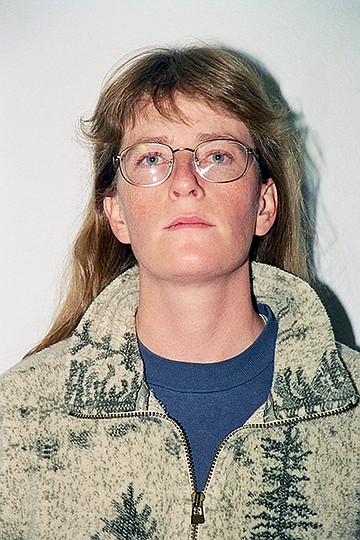
Some, but not all of Stansfield’s allegations, are documented in the deposition testimony of Tenaya Webb and her erstwhile girlfriend, Jennifer Joy, with whom Webb had a stormy, on-again, off-again relationship from February 2000 through April 2001. In an effort to discover whether Webb was imbued with any tendencies toward violence, Stansfield’s attorneys questioned Webb and Joy about their love affair and other topics.
Joy was candid, testifying that she and Webb had engaged in “sadomasochistic practices” and had a “rough” sex life. Stating that Webb was obsessed with her gun as well as with Joy’s two young sons, she stated that she was fearful for her safety and that of her boys’. She spoke of an incident on Mast Boulevard in Santee, saying that Webb, while off duty and out-of-uniform (while driving with Joy and one of Joy’s sons), whipped around in a u-turn and crossed a double yellow line in order to confront two teenagers who were arguing in front of a condominium complex. Webb got out of the car and “commanded” them to stop arguing with one another. Joy says that Webb was carrying her gun at the time.
Joy stated under oath that Webb had confided to her that, during a police convention attended by Webb in Los Angeles, Webb was drunk, depressed, possibly suicidal — and that during dinner in the presence of other officers, she disassembled her gun and put it together again. According to Joy, Webb had told her that the officers were concerned about Webb’s safety and may have attempted to take the gun away from Webb so she couldn’t take it up to her hotel room later that evening. When deposed, Webb confessed to being at the convention but denied allegations regarding the gun.
Joy said that Webb had told her of two wrist-slashing suicide attempts that took place when Webb was 12 and 16; Webb refused to answer when asked if she’d ever attempted to kill herself.
The deposition testimony contains extensive discussion regarding Webb’s participation in counseling sessions sponsored by and apparently mandated by the El Cajon Police Department, about which Webb was reluctant to divulge details.
Healing has been slow for Stansfield. “I still talk about my son like he’s here, and when people find out he’s not, it kind of shocks them. I think about him every single day, and I still break down. I try to tell my story. There is nothing I wouldn’t have done for my kid; he was my best friend. When I had nobody else, he was there. He was my baby, and to me he was a good boy. Maybe not to the rest of the world, but…he’d never hurt anybody; he was funny and was always being silly.”
I asked Stansfield about Chris’s pals. “His friends loved him to death. In fact, I’m still in touch with Sean Nolan; he’s getting better, but he’s still emotionally scarred. That poor kid spent six or eight hours covered with my son’s blood while they interrogated him.”
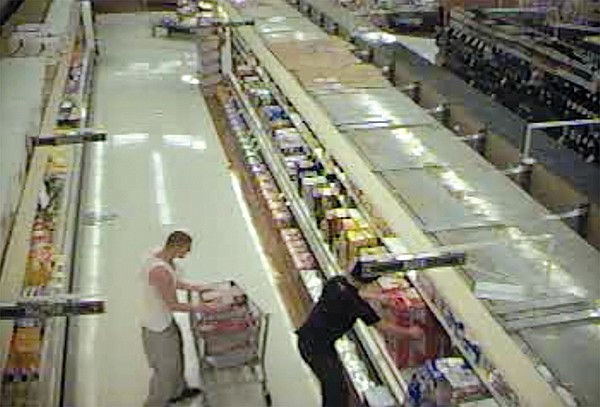
In Stansfield’s view, “beer runs” are a ubiquitous, if edgy, custom. “My son was shot for something that many people call a ‘teenage rite.’ Teenagers are always going to do something stupid; that’s just what they do, especially when you get a bunch of teenage boys together and they’ve been drinkin.’ There’s not a teenager out there — not you, not me —that hasn’t stolen something at some point. I’d never done a beer run, but I think almost every boy has; I know my four brothers did. How it all started with Chris? It was a stupid thing to do — they were just helping a friend move and went to his house and started drinking to celebrate the move. My son drank a lot; I’m not going to say he didn’t.
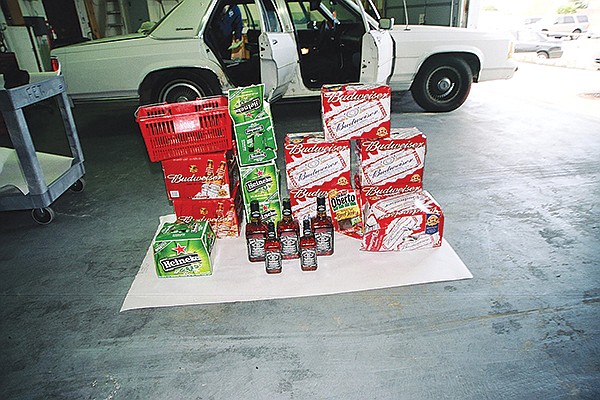
“All told, how much was the booze worth? Stansfield recalls, “Chris had five or six bottles of Jack [Daniel’s] in a carrying case, while Kevin Carter maybe had a few hundred dollars’ worth of beer stacked up in a the cart.” Chuckling, she adds, “The other side said it was ‘just over’ the point of not being a misdemeanor.”
Stansfield is critical of, and puzzled by, the trial judge’s decision to exclude certain, pivotal evidence.
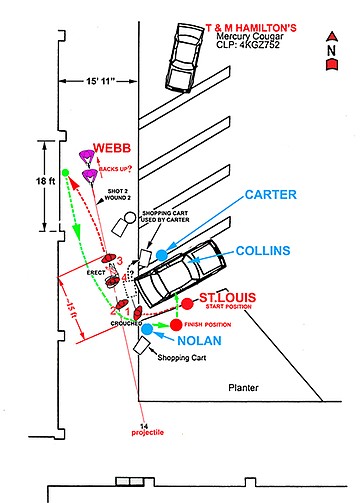
“Someone had called 911 and there was a recording of Webb shooting my son; it proved that there were four shots, ‘bang, bang, bang, bang’ — not one initial shot and then three others as Webb claimed. There was no stopping the shots. But the tape [most of it, except the last 30 seconds] was thrown out by the judge. They wouldn’t let it come in as evidence; I don’t know why. Before it happened, Cline told me that they were gonna do that to me, and that if the defense could show that Webb was in fear for her life, they could turn this thing around. I thought, What? My son was the victim, not Webb! She shot and killed Chris, and she wasn’t even in uniform. I was so pissed and confused. I said, ‘What kind of justice system is this where your son can be murdered by a police officer for no good reason?’ The defense claimed that he was trying to go after her gun, but there’s no way he could’ve even touched it. And he had no clue she was a cop; not one of the witnesses ever said that she identified herself.”
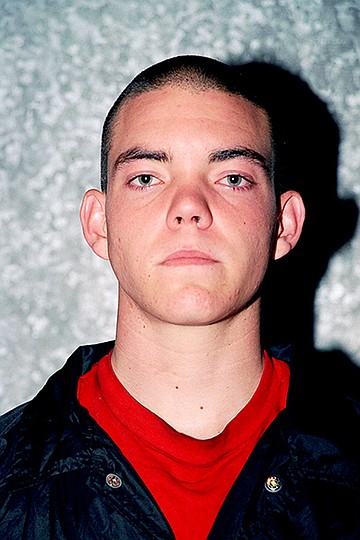
In most civil lawsuits for damages, depositions are among the most important components used by attorneys in their attempt to prove, or counter, allegations of liability. As such, the “depo” (as it’s colloquially known among litigators) can be both exhaustive and exhausting, taking up hours, if not days in testimony, as set forth in transcripts often stretching to several hundred pages. After the complaint was filed and answered by the defendants, it fell to Heather Kelleher (née Flynn), an associate at White and Bright, to take nearly all the depositions in the action. Among the dozen or so depos conducted in 2005 were accounts from St. Louis’s best friend, 18-year-old Max Collins, as well as testimony by buddy Sean Nolan, 17, and Kevin Carter, also 17, a kid St. Louis had met the day of the shooting. What Kelleher uncovered was a story that is both technical in detail and emotional in tone, the story of a routine day at the supermarket turned last rites for a teenager.
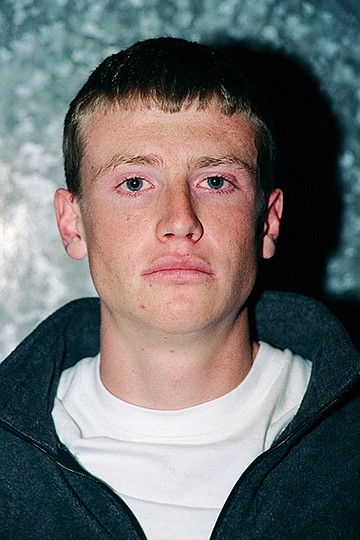
When I spoke with Kelleher, who has since relocated to Washington DC, I was struck by the clarity of her recollection, given the decade’s hiatus since the shooting. I asked if the jurors, whom Kelleher remembers as primarily white women in their 40s and 50s, were unsympathetic. “They didn’t like our client; she was kind of a rough woman, but I really liked her, and she really loved her son.
“It wasn’t the picture-perfect family, but it also wasn’t an abusive home or anything like that. It was a working-class area, and these folks were rough around the edges. Still, I don’t think the deposition testimony of Christopher’s’ friends hurt the case; they were very honest. I liked them. They weren’t your straight-A students, involved in school clubs and stuff like that, but they were nice, good kids. They may have gotten into trouble and could be characterized by some as ‘white trash,’ but quite frankly, I’d like to have their loyalty, the way they’d lay down their life for you.”
But, concedes Kelleher, “A lot of people would definitely see them as ‘bad.’ Two of the friends were incarcerated, at the time they were deposed, for minor things; I certainly don’t remember them being violent crimes. They were guys without direction, on the fringes, just teenagers getting into trouble. They had each other.”
Would the outcome have been the same had Chris’s friends not been incarcerated or viewed as petty hoodlums? Kelleher opines, “I think things would have been different. I wouldn’t go as far as to say that the jurors thought he ‘deserved it,’ but they probably thought, They were doing something wrong, stealing beer. The jurors weren’t concerned with the fact that an off-duty, out-of-uniform cop — who didn’t identify herself — chased after the boys with a gun. It’s almost like the jurors didn’t look at that part of the equation.”
Concerning Webb’s failure to identify herself, Kelleher said of jurors, “They probably didn’t care.”
About three weeks into the trial, which had commenced on May 22, 2006, Stansfield began to have trepidations and mulled dismissing the case. According to Kelleher, there were a number of reasons for Stansfield’s decision to throw in the towel.
“First,” recalls the attorney, “it was very difficult emotionally, and second, it wasn’t going our way. It was pretty clear that the jurors were not on our side, and actually, after the dismissal (I was there), we were able to talk to the jury and confirm that.”
Was there a turning point in the truncated trial?
“These cases are hard,” opines Kelleher. “San Diego juries are very conservative, giving law enforcement the benefit of a doubt. And when the judge kept out some things like the 911 tape and some other evidence, it was clear that we were going to lose.”
Kelleher notes that Webb’s attorneys attempted to paint a less-than-savory picture of St. Louis. “The other side brought up the ‘iron cross’ tattoo that Chris had, but according to everyone we talked to, he was not a white supremacist.”
Crystal Stansfield adds, “They were going to make it look like my son was a thug, a skinhead — and he was none of those things. Next, they were gonna start dragging my whole family through the mud, and I wasn’t having any of that, either. I was done exposing him; he didn’t deserve that. Also, I didn’t want to see the autopsy photos. I couldn’t handle seeing my son like that.”
Bryan Burnett’s image of Christopher St. Louis is one borne of autopsy photos, blood-spatter patterns and exit wounds. And as a counterpoint to Heather Kelleher’s simpatico, almost wistful reminiscence of St. Louis’s buddies, Burnett, tapped as an expert witness for the plaintiff, expresses his analysis of the shooting in a detached fashion.
I met with Burnett at his Meixa Tech lab, tucked away in a small building behind his house in Cardiff. If one were to construct a man-fort with a scanning electron microscope instead of a wet bar, forensic reports instead of skin mags, this could be the template.
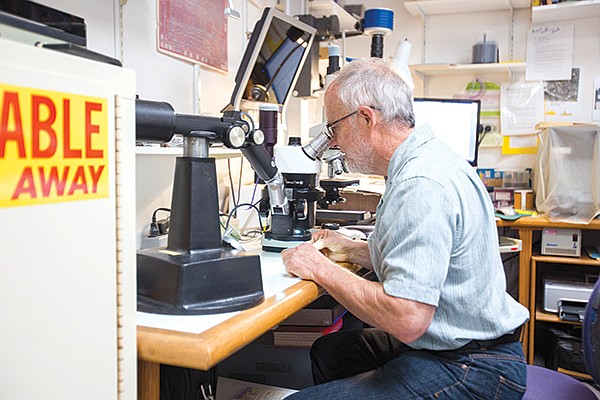
Burnett continues to find the case not only fascinating, but a source of professional pride.
“It’s the circumstances,” he says. “St. Louis approached the shooter and got shot four times, which is incredible. He received a fatal torso shot and started bleeding within seconds; he was bleeding out very, very quickly. Although that’s gross from a public standpoint, it’s an important observation for other homicides, which is why my paper got published.”
Burnett adds that while rapid blood loss from a gunshot wound is not uncommon, it “hasn’t been clearly documented in the literature.”
Burnett evinces a strong preference for delineating the perimeters of his analytical realm.
“What a lot of my associates don’t seem to be careful about is, ‘just where does my expertise end?’ In my case, it ends when there’s a medical opinion, that’s for certain. But for other experts, especially MDs — they go all over the place. That’s why, when someone calls me up for an initial inquiry, I want to make sure what they expect me to do. If they expect me to look at a firearm and comment on the functuality, ‘Oh, no,’ that’s a firearms expert. My areas include gunshot residue, blood-spatter analysis, and scene reconstruction. More often than not, the client is looking for analysis of gunshot residue, but I also do crime-scene reconstruction. Here, we did the reconstruction at a gym, Cardiffit. That was fun.”
Burnett explains his methodology.
“A reconstructionist tries to work with everything that’s available to form a hypothesis — a temporary conclusion that stands unless new evidence is uncovered. All the evidence that I examined in this case indicates that my original hypothesis of when St. Louis was initially shot remains valid. This includes taking into account the trajectory of the bullets and paths through St. Louis. He wasn’t fully facing Webb when he received the fatal chest bullet; he was facing the tobacco store, crouched forward at a 20-degree angle. He had to have been just starting his run toward Webb when he received that first bullet....
“The issue was, ‘When did she start shooting?’ And looking at the parameters of that, i.e., when St. Louis started his run towards her from the side of the car to stopping — which was right beside the shooter, Webb — St. Louis had a certain amount of momentum. Webb and the other witnesses commented on that rate of motion towards the shooter, and that’s when it really required a re-enactment. The distance covered was about 30 feet and it required St. Louis to foot-slap to slow down and come to a complete stop without overrunning the position of Ms. Webb. She claimed that the final shot was quite close to St. Louis.”
Burnett’s findings contradict Webb’s assertion.
“Under those circumstances,” he explains, “one of the things that happens with the discharge of a firearm is that not all of the gunpowder is burned; within a certain range, there will be an amount of gunpowder deposited in the target. The question is, ‘Does the powder itself have enough momentum to penetrate the skin of the recipient of the bullet?’ That’s where the issue of tattooing, or stippling, comes in. When the powder enters the skin, it causes a little bit of bruising, black-and-blue marks that look like tattoos. I found neither gunshot residue nor stippling on St. Louis. My conclusion was that Webb’s first shot was from about 30 feet away, the last from about 15 feet.”
Did Tenaya Webb use excessive force? Burnett, whose assiduous protocol is to steer well clear of legal conclusions, replies, “That’s for a jury to decide; all I do is the reconstruction. I don’t comment on behavioral issues like that; it’s not my area, and I don’t purport it to be. I don’t inject my viewpoint into the analysis. As a scientist, I put together the whole situation, interpreting witnesses’ statements in the context of the reconstruction. Since I wasn’t there, I do the best I can to say, in that short five seconds or so, ‘What the hell happened?’”
I asked Burnett about the autopsy photos, those nightmare images, the ones that Crystal Stansfield was ultimately spared. As inured as he might be to the clinical gore of post-mortem candids, he says, “I understand.” But whatever role Stansfield’s imminent viewing of her son’s gunshot-riddled corpse might have played in the decision to bail out, Burnett never had the opportunity to testify.
Stansfield harbors no illusions about her only child.
“My son wasn’t perfect; he could be quite the little shit when he wanted to be. I never denied any of it. But he wasn’t a bad kid. Chris had never been to jail; he was just doin’ stupid teenage shit. He drank a lot and hung out with a lot of kids who also weren’t perfect. He smoked pot, but he’d quit at that point. He failed high school miserably but wanted to get his GED; he was actually trying to get a job. The day after he died, Target phoned me because they were calling him back for a second interview. When I told the guy that Chris had passed away, he said, ‘Oh, God, I’m so sorry,’ and basically just hung up. What else can you say after that?”
Stansfield is candid about her son’s upbringing. “I wasn’t the perfect mom; I did my best, like most moms do. There was no help from his father, who’s a piece of crap. We didn’t talk. I had to call him while he was in prison to tell him that his kid was dead. He hadn’t seen my son since he was 12 years old, anyway.”
In light of recent events, I posited a “race” angle hypothetical to Stansfield: “Would the media have treated the story differently had you and your son been black?”
“I hate to say it, but absolutely. They would’ve gone crazy over it, and it sucks, because it’s not fair. I was interviewed once, and we had a news crew at my house for an hour or two, but that was it.”
When I asked the same question of Kelleher, she replied, “I don’t know if that would be different these days, now that police brutality and officer-involved shootings where someone is unarmed have received a lot of publicity nationwide.”
“Is there a double standard?” I wondered. “Is it easier to get away with shooting a white person?”
“I don’t know,” said Kelleher. “I think a lot of people would say that it’s the opposite. Police shootings happen in all kinds of circumstances. Unarmed white people are shot by officers, unarmed Hispanic people are shot by officers, black people, homeless people — all segments of the population. I don’t think it’s unfair to say that cops protect their own; however, we’ve seen instances recently where there have been shootings and the police department fires an officer right away.”
Kelleher described Webb’s demeanor as a witness.
“She was a little hostile about the fact that she was being sued. It was a difficult situation for her; it’s not fun to be a defendant. I don’t think she’s mean or malicious, but she didn’t express regret; that’s difficult for a defendant who’s a representative of the police department to do, because it might equal liability.”
Some time after Stansfield — faced with imminent defeat because of the judge’s evidentiary ruling — had decided to throw in the towel, she met with Webb. “I didn’t understand how they were able to close the case like that, but I was tired of it and just wanted it to be over. The one thing I requested was, if I’m going to sign an affidavit that I’ll never sue you guys again for this, I want to talk to her. Because I need to understand why she shot my kid, and I need to understand who she is. I can’t walk away from this whole thing, because this woman is a complete monster and a crazy person.”
Stansfield recounted the meeting with Webb, the aftermath of which reveals a complex and contradictory amalgam of emotions. “It was quite enlightening. She didn’t come across as crazy to me; she sounded like a normal person. She sobbed the entire time we talked, a good hour, and said that she didn’t sleep at night. She also said that she had no intentions of killing my son, which has lifted the hugest burden in the world off of me. I forgave her for it because it was never going to end if I didn’t. It would just continue to be something I’d hold in the back of my head forever, so talking to her was the only way to stop it for me.”
Kelleher comments, “Crystal got a lot of peace from meeting with Webb. Crystal wasn’t after the money; she just really needed someone to recognize that this didn’t happen because her son was ‘bad’ or because the officer was out to kill him. I don’t know what was actually said, but Crystal was able to move on — not from losing her child, but away from the anger. I think that sometimes, mercy is better than justice.”
Kelleher confirms what the layman suspects.
“Litigation is hard, and a lot of times, it’s not worth putting someone through it.” She laughs, “It’s not helpful to a lot of people.”
I asked Kelleher, “How much did White & Bright lose on the case?”
“I’m not comfortable discussing it, but it had to be at least a hundred grand.”
I asked Kelleher whether the in-trial dismissal was a problem for White & Bright.
“Well, it wasn’t for me, personally. Whatever would help Crystal get over the pain of losing her son. Of course, in litigation, there are a lot of expenses, and you’d like to see it through. On the other hand, if you think the trial isn’t going your way, why spend more money? My understanding is that it was Crystal’s idea to dismiss.... We were coming up to the part of the trial where there’d be a lot of photos of the body.”
Nonetheless, Stansfield praises her attorney’s tenacity.
“Mr. Cline was a bulldog. He said, ‘We can keep going until you’re done; I’ve got two kids and I know how it feels.’ But, the other side threatened to sue me for $50k if I continued and I lost, and that was another reason I decided to quit. We waited three years to start the damn case, then they dragged me through the mud for three weeks. When you’re trying to beat a police department, you feel like you’re fighting a bigger fish than you are.”
I asked Kelleher, “Do you think justice was served in this case?”
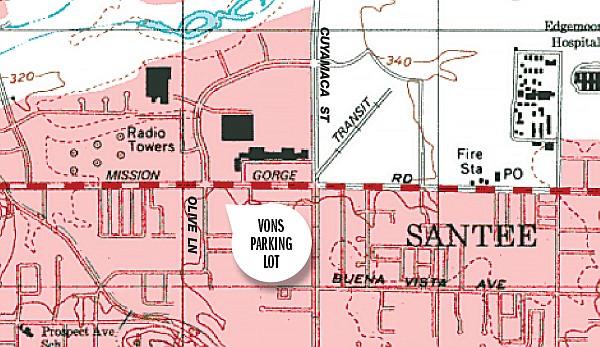
“In my opinion, no. Chris was unarmed. He was stealing beer and getting into the car, fleeing the scene. He and his friends were pursued by a woman whom they had no idea was a police officer rather than some ‘good Samaritan’ who was trying to stop them from taking the beer. I think police are encouraged not to get involved when they’re off-duty and out of uniform, and maybe there need to be some changes in policies and procedures within police departments about that. Certainly the policy of shooting to kill is not a good thing.”
Death penalty for a misdemeanor?
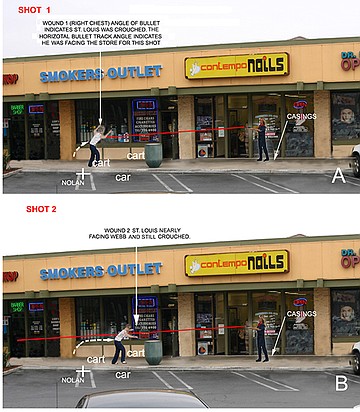
“In my opinion, yes,” states Kelleher. “But I don’t think she intended to shoot Chris to get the beer back. Why she brought a gun into the picture at all is beyond me. What Webb did wrong was to escalate the crime. The policy of stores is that you don’t pursue someone who’s stealing because you’ll make a situation worse. I mean, you take out a gun when you haven’t seen any sign that these kids are armed?” Kelleher laughs, “Chasing them with a gun was probably not the wisest decision....
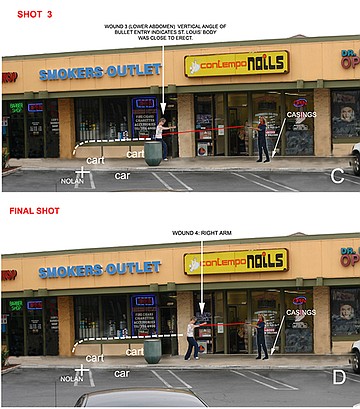
“When Webb got close to the vehicle, it was dark, and witnesses testified that Chris tried to scare her off with a fake motion toward her as if to say, ‘Go away.’ Webb claimed that she thought it was a potential threat on her life. In all fairness, there was not a lot of time to make a decision. If you listen to the 911 tape, you’ll hear that from the time a witness makes a call on his cell phone, ‘There’s a lady with a gun,’ it’s a matter of seconds until you hear the shots fired. Not a lot of time passed from when Webb left the store to when Chris was killed.”
Can the St. Louis shooting be differentiated from, for example, the widely publicized Michael Brown shooting in terms of “excessive force”? Was it reasonable for Webb to have believed that her life was in danger or that grievous bodily harm was imminent?
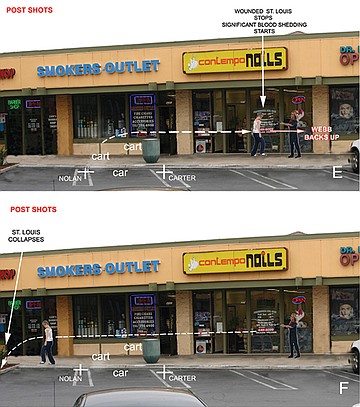
“She had sort of backed herself into a corner at that point,” says Kelleher. “She didn’t know if these kids had weapons on them, and one of them, Chris, moved towards her to scare her off, not knowing she was a cop.... Maybe she believed he had something in his hands, or… Whatever happened, she apparently got scared. In hindsight, some officers, having made the quick decision, the judgment call to shoot someone — and then finding out that the individual was unarmed — wish they hadn’t. I don’t know if that’s true for Webb — if she’s sorry it happened. You’d have to ask her.”
I queried Kelleher, “Are you troubled by the fact that Webb has been able to continue her career while St. Louis is six feet under?”
“It’s very sad that Chris was killed and that his life ended at a young age. It was up to the police department to determine whether Webb was suitable to continue working. It doesn’t bother me, per se, but I’d have concerns: Is this going to happen again? Is someone else going to get hurt because of a bad decision by this officer? I would imagine she would have been disciplined at some point.”
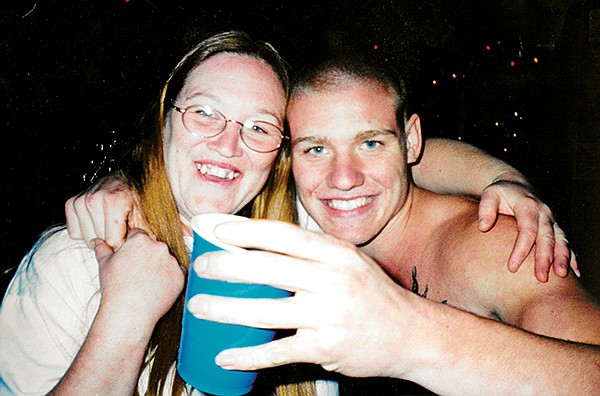
Crystal Stansfield doesn’t restrict blame for her son’s death to Webb, however.
“Kevin Carter, that rotten little bastard, if I catch him, I’d like to give him a piece of my mind. I feel like he’s the reason my son’s dead, because he wouldn’t stop putting the damn beer in the car. Chris and the others kept telling him, ‘Leave it alone, leave it alone.’ They were trying to leave, but he refused to quit, and that’s how Webb caught up with them. Then, Carter ran and got away with that for a full year.”
In the aftermath, Kelleher retains a sense of affection for Stansfield.
“I’d like to know how she’s doing; she’s a nice woman.” However Stansfield’s faring, she’s no better off financially. The complaint, eventually dismissed on July 3, 2006, had alleged damages of $3,000,000-plus. The plaintiff’s’ trial brief stated, “The loss of her son’s life is immeasurable.” But Stansfield maintains, “It wasn’t about money; it was about determining that Webb was crazy and shouldn’t be a cop.”
By all accounts, Tenaya Webb is doing well. According to “Transparent California,” a website that endeavors to list the position and compensation for every public employee in the state, Webb is still with the El Cajon Police Department, working at a desk job. Her compensation in 2012, the latest year for which information is available on the site, was $113,666.93.
In an attempt to contact her, I spoke with Lt. Rob Ransweiler of the El Cajon Police Department. Ransweiler told me that Webb, now a sergeant, might be willing to comment on the fatal shooting — but only if Crystal Stansfield agreed to speak with me in detail. (At the time of this story’s completion, Webb had neither contacted me nor issued a statement via Ransweiler.)
The El Cajon Police Department has circled the wagons.
“Speaking for the Department,” offers Ransweiler, “there’s not a whole lot we can say, because we didn’t do the investigation.”
As for the San Diego County Sheriff’s Department, spokesperson Jan Caldwell replied, “I’ve consulted our homicide captain and due to the age of this case, and that the involved individuals are no longer with this department, we do not have any statement or comment to make.”
Webb was not prosecuted for the shooting of St. Louis. On September 5, 2003, around seven months before the civil suit was filed, San Diego County district attorney Bonnie Dumanis, in a report issued to San Diego County sheriff Bill Kolender, concluded: “Officer Webb was confronted by a physically imposing — the autopsy report states, ‘St. Louis was 5 feet 11 1/2 inches and 161 pounds’ — highly intoxicated individual, who after committing a commercial burglary with his companions, essentially turned the incident into a robbery by charging at her. Christopher St. Louis charged at Officer Webb in such an intimidating, threatening manner that she reasonably feared for her personal safety. Clearly, she waited until he was virtually on her before she chose to defend herself. Her use of deadly force in this case was justified and she bears no criminal liability for her actions.”
As it happens, on May 21 of this year, Webb spoke at a conference of the San Diego chapter of Romance Writers of America held at the Best Western Seven Seas in Mission Valley. Her billing? “How Police Solve Murders with Sergeant Tenaya Webb.”


The bloodstains have long since faded, courtesy of Scram, sun, and time. More than a decade ago, in the parking lot of a Vons in Santee, Christopher St. Louis, 18, lost his life in the pursuit of free beer, shot by off-duty El Cajon police officer Tenaya Webb.

On February 16, 2003, a Sunday evening, St. Louis and three buddies were out on a “beer run” when they ran into Webb. According to homicide investigator Lt. Terry Wisniewski, Webb had been shopping when she saw the teens loading cases of beer from a shopping cart into a car. Notwithstanding her off-duty status, and apparently surmising that St. Louis and the others were stealing the beer (misdemeanor shoplifting), Webb ordered the youths to “put the beer back,” after which they’d ostensibly be free to go.
What happened next will sound familiar to anyone scanning the news these days: shots fired, a young man dead, and a police officer placed on paid administrative leave. But the story line deviated at this juncture, because there was no race angle, no “Black Lives Matter,” no riots, not even a mild-mannered protest in front of police headquarters. It was just another case of the death penalty for disobeying a cop, a white-on-white shooting recounted in a news story in the local paper, garnering little attention elsewhere and no hubbub of which to speak. Crystal Stansfield had lost a son; perhaps not an angelic, perfect son, certainly no Son of God, but a son nonetheless.
Some time after the shooting, after the funeral and the fundraiser at Iguana’s on Mission Gorge Road, where she worked as a bartender, Stansfield contacted attorney Stephen G. Cline. “He told me, ‘I’ve never done anything like this before; but I have two sons — come in and talk to me.’”
On April 2, 2004, Cline, who was later joined by the firm of White and Bright, filed a wrongful death suit in federal court against the El Cajon Police Department, the City of El Cajon, and Tenaya Webb. The complaint, on behalf of Stansfield and the estate of St. Louis, alleged that Webb, by dint of negligence, had violated St. Louis’s Fourth Amendment rights.
Stansfield, who works as a pet groomer at a Petco in Santee, is eager to lend her perspective. “There are a lot of things that people don’t know.”

Some, but not all of Stansfield’s allegations, are documented in the deposition testimony of Tenaya Webb and her erstwhile girlfriend, Jennifer Joy, with whom Webb had a stormy, on-again, off-again relationship from February 2000 through April 2001. In an effort to discover whether Webb was imbued with any tendencies toward violence, Stansfield’s attorneys questioned Webb and Joy about their love affair and other topics.
Joy was candid, testifying that she and Webb had engaged in “sadomasochistic practices” and had a “rough” sex life. Stating that Webb was obsessed with her gun as well as with Joy’s two young sons, she stated that she was fearful for her safety and that of her boys’. She spoke of an incident on Mast Boulevard in Santee, saying that Webb, while off duty and out-of-uniform (while driving with Joy and one of Joy’s sons), whipped around in a u-turn and crossed a double yellow line in order to confront two teenagers who were arguing in front of a condominium complex. Webb got out of the car and “commanded” them to stop arguing with one another. Joy says that Webb was carrying her gun at the time.
Joy stated under oath that Webb had confided to her that, during a police convention attended by Webb in Los Angeles, Webb was drunk, depressed, possibly suicidal — and that during dinner in the presence of other officers, she disassembled her gun and put it together again. According to Joy, Webb had told her that the officers were concerned about Webb’s safety and may have attempted to take the gun away from Webb so she couldn’t take it up to her hotel room later that evening. When deposed, Webb confessed to being at the convention but denied allegations regarding the gun.
Joy said that Webb had told her of two wrist-slashing suicide attempts that took place when Webb was 12 and 16; Webb refused to answer when asked if she’d ever attempted to kill herself.
The deposition testimony contains extensive discussion regarding Webb’s participation in counseling sessions sponsored by and apparently mandated by the El Cajon Police Department, about which Webb was reluctant to divulge details.
Healing has been slow for Stansfield. “I still talk about my son like he’s here, and when people find out he’s not, it kind of shocks them. I think about him every single day, and I still break down. I try to tell my story. There is nothing I wouldn’t have done for my kid; he was my best friend. When I had nobody else, he was there. He was my baby, and to me he was a good boy. Maybe not to the rest of the world, but…he’d never hurt anybody; he was funny and was always being silly.”
I asked Stansfield about Chris’s pals. “His friends loved him to death. In fact, I’m still in touch with Sean Nolan; he’s getting better, but he’s still emotionally scarred. That poor kid spent six or eight hours covered with my son’s blood while they interrogated him.”

In Stansfield’s view, “beer runs” are a ubiquitous, if edgy, custom. “My son was shot for something that many people call a ‘teenage rite.’ Teenagers are always going to do something stupid; that’s just what they do, especially when you get a bunch of teenage boys together and they’ve been drinkin.’ There’s not a teenager out there — not you, not me —that hasn’t stolen something at some point. I’d never done a beer run, but I think almost every boy has; I know my four brothers did. How it all started with Chris? It was a stupid thing to do — they were just helping a friend move and went to his house and started drinking to celebrate the move. My son drank a lot; I’m not going to say he didn’t.

“All told, how much was the booze worth? Stansfield recalls, “Chris had five or six bottles of Jack [Daniel’s] in a carrying case, while Kevin Carter maybe had a few hundred dollars’ worth of beer stacked up in a the cart.” Chuckling, she adds, “The other side said it was ‘just over’ the point of not being a misdemeanor.”
Stansfield is critical of, and puzzled by, the trial judge’s decision to exclude certain, pivotal evidence.

“Someone had called 911 and there was a recording of Webb shooting my son; it proved that there were four shots, ‘bang, bang, bang, bang’ — not one initial shot and then three others as Webb claimed. There was no stopping the shots. But the tape [most of it, except the last 30 seconds] was thrown out by the judge. They wouldn’t let it come in as evidence; I don’t know why. Before it happened, Cline told me that they were gonna do that to me, and that if the defense could show that Webb was in fear for her life, they could turn this thing around. I thought, What? My son was the victim, not Webb! She shot and killed Chris, and she wasn’t even in uniform. I was so pissed and confused. I said, ‘What kind of justice system is this where your son can be murdered by a police officer for no good reason?’ The defense claimed that he was trying to go after her gun, but there’s no way he could’ve even touched it. And he had no clue she was a cop; not one of the witnesses ever said that she identified herself.”

In most civil lawsuits for damages, depositions are among the most important components used by attorneys in their attempt to prove, or counter, allegations of liability. As such, the “depo” (as it’s colloquially known among litigators) can be both exhaustive and exhausting, taking up hours, if not days in testimony, as set forth in transcripts often stretching to several hundred pages. After the complaint was filed and answered by the defendants, it fell to Heather Kelleher (née Flynn), an associate at White and Bright, to take nearly all the depositions in the action. Among the dozen or so depos conducted in 2005 were accounts from St. Louis’s best friend, 18-year-old Max Collins, as well as testimony by buddy Sean Nolan, 17, and Kevin Carter, also 17, a kid St. Louis had met the day of the shooting. What Kelleher uncovered was a story that is both technical in detail and emotional in tone, the story of a routine day at the supermarket turned last rites for a teenager.

When I spoke with Kelleher, who has since relocated to Washington DC, I was struck by the clarity of her recollection, given the decade’s hiatus since the shooting. I asked if the jurors, whom Kelleher remembers as primarily white women in their 40s and 50s, were unsympathetic. “They didn’t like our client; she was kind of a rough woman, but I really liked her, and she really loved her son.
“It wasn’t the picture-perfect family, but it also wasn’t an abusive home or anything like that. It was a working-class area, and these folks were rough around the edges. Still, I don’t think the deposition testimony of Christopher’s’ friends hurt the case; they were very honest. I liked them. They weren’t your straight-A students, involved in school clubs and stuff like that, but they were nice, good kids. They may have gotten into trouble and could be characterized by some as ‘white trash,’ but quite frankly, I’d like to have their loyalty, the way they’d lay down their life for you.”
But, concedes Kelleher, “A lot of people would definitely see them as ‘bad.’ Two of the friends were incarcerated, at the time they were deposed, for minor things; I certainly don’t remember them being violent crimes. They were guys without direction, on the fringes, just teenagers getting into trouble. They had each other.”
Would the outcome have been the same had Chris’s friends not been incarcerated or viewed as petty hoodlums? Kelleher opines, “I think things would have been different. I wouldn’t go as far as to say that the jurors thought he ‘deserved it,’ but they probably thought, They were doing something wrong, stealing beer. The jurors weren’t concerned with the fact that an off-duty, out-of-uniform cop — who didn’t identify herself — chased after the boys with a gun. It’s almost like the jurors didn’t look at that part of the equation.”
Concerning Webb’s failure to identify herself, Kelleher said of jurors, “They probably didn’t care.”
About three weeks into the trial, which had commenced on May 22, 2006, Stansfield began to have trepidations and mulled dismissing the case. According to Kelleher, there were a number of reasons for Stansfield’s decision to throw in the towel.
“First,” recalls the attorney, “it was very difficult emotionally, and second, it wasn’t going our way. It was pretty clear that the jurors were not on our side, and actually, after the dismissal (I was there), we were able to talk to the jury and confirm that.”
Was there a turning point in the truncated trial?
“These cases are hard,” opines Kelleher. “San Diego juries are very conservative, giving law enforcement the benefit of a doubt. And when the judge kept out some things like the 911 tape and some other evidence, it was clear that we were going to lose.”
Kelleher notes that Webb’s attorneys attempted to paint a less-than-savory picture of St. Louis. “The other side brought up the ‘iron cross’ tattoo that Chris had, but according to everyone we talked to, he was not a white supremacist.”
Crystal Stansfield adds, “They were going to make it look like my son was a thug, a skinhead — and he was none of those things. Next, they were gonna start dragging my whole family through the mud, and I wasn’t having any of that, either. I was done exposing him; he didn’t deserve that. Also, I didn’t want to see the autopsy photos. I couldn’t handle seeing my son like that.”
Bryan Burnett’s image of Christopher St. Louis is one borne of autopsy photos, blood-spatter patterns and exit wounds. And as a counterpoint to Heather Kelleher’s simpatico, almost wistful reminiscence of St. Louis’s buddies, Burnett, tapped as an expert witness for the plaintiff, expresses his analysis of the shooting in a detached fashion.
I met with Burnett at his Meixa Tech lab, tucked away in a small building behind his house in Cardiff. If one were to construct a man-fort with a scanning electron microscope instead of a wet bar, forensic reports instead of skin mags, this could be the template.

Burnett continues to find the case not only fascinating, but a source of professional pride.
“It’s the circumstances,” he says. “St. Louis approached the shooter and got shot four times, which is incredible. He received a fatal torso shot and started bleeding within seconds; he was bleeding out very, very quickly. Although that’s gross from a public standpoint, it’s an important observation for other homicides, which is why my paper got published.”
Burnett adds that while rapid blood loss from a gunshot wound is not uncommon, it “hasn’t been clearly documented in the literature.”
Burnett evinces a strong preference for delineating the perimeters of his analytical realm.
“What a lot of my associates don’t seem to be careful about is, ‘just where does my expertise end?’ In my case, it ends when there’s a medical opinion, that’s for certain. But for other experts, especially MDs — they go all over the place. That’s why, when someone calls me up for an initial inquiry, I want to make sure what they expect me to do. If they expect me to look at a firearm and comment on the functuality, ‘Oh, no,’ that’s a firearms expert. My areas include gunshot residue, blood-spatter analysis, and scene reconstruction. More often than not, the client is looking for analysis of gunshot residue, but I also do crime-scene reconstruction. Here, we did the reconstruction at a gym, Cardiffit. That was fun.”
Burnett explains his methodology.
“A reconstructionist tries to work with everything that’s available to form a hypothesis — a temporary conclusion that stands unless new evidence is uncovered. All the evidence that I examined in this case indicates that my original hypothesis of when St. Louis was initially shot remains valid. This includes taking into account the trajectory of the bullets and paths through St. Louis. He wasn’t fully facing Webb when he received the fatal chest bullet; he was facing the tobacco store, crouched forward at a 20-degree angle. He had to have been just starting his run toward Webb when he received that first bullet....
“The issue was, ‘When did she start shooting?’ And looking at the parameters of that, i.e., when St. Louis started his run towards her from the side of the car to stopping — which was right beside the shooter, Webb — St. Louis had a certain amount of momentum. Webb and the other witnesses commented on that rate of motion towards the shooter, and that’s when it really required a re-enactment. The distance covered was about 30 feet and it required St. Louis to foot-slap to slow down and come to a complete stop without overrunning the position of Ms. Webb. She claimed that the final shot was quite close to St. Louis.”
Burnett’s findings contradict Webb’s assertion.
“Under those circumstances,” he explains, “one of the things that happens with the discharge of a firearm is that not all of the gunpowder is burned; within a certain range, there will be an amount of gunpowder deposited in the target. The question is, ‘Does the powder itself have enough momentum to penetrate the skin of the recipient of the bullet?’ That’s where the issue of tattooing, or stippling, comes in. When the powder enters the skin, it causes a little bit of bruising, black-and-blue marks that look like tattoos. I found neither gunshot residue nor stippling on St. Louis. My conclusion was that Webb’s first shot was from about 30 feet away, the last from about 15 feet.”
Did Tenaya Webb use excessive force? Burnett, whose assiduous protocol is to steer well clear of legal conclusions, replies, “That’s for a jury to decide; all I do is the reconstruction. I don’t comment on behavioral issues like that; it’s not my area, and I don’t purport it to be. I don’t inject my viewpoint into the analysis. As a scientist, I put together the whole situation, interpreting witnesses’ statements in the context of the reconstruction. Since I wasn’t there, I do the best I can to say, in that short five seconds or so, ‘What the hell happened?’”
I asked Burnett about the autopsy photos, those nightmare images, the ones that Crystal Stansfield was ultimately spared. As inured as he might be to the clinical gore of post-mortem candids, he says, “I understand.” But whatever role Stansfield’s imminent viewing of her son’s gunshot-riddled corpse might have played in the decision to bail out, Burnett never had the opportunity to testify.
Stansfield harbors no illusions about her only child.
“My son wasn’t perfect; he could be quite the little shit when he wanted to be. I never denied any of it. But he wasn’t a bad kid. Chris had never been to jail; he was just doin’ stupid teenage shit. He drank a lot and hung out with a lot of kids who also weren’t perfect. He smoked pot, but he’d quit at that point. He failed high school miserably but wanted to get his GED; he was actually trying to get a job. The day after he died, Target phoned me because they were calling him back for a second interview. When I told the guy that Chris had passed away, he said, ‘Oh, God, I’m so sorry,’ and basically just hung up. What else can you say after that?”
Stansfield is candid about her son’s upbringing. “I wasn’t the perfect mom; I did my best, like most moms do. There was no help from his father, who’s a piece of crap. We didn’t talk. I had to call him while he was in prison to tell him that his kid was dead. He hadn’t seen my son since he was 12 years old, anyway.”
In light of recent events, I posited a “race” angle hypothetical to Stansfield: “Would the media have treated the story differently had you and your son been black?”
“I hate to say it, but absolutely. They would’ve gone crazy over it, and it sucks, because it’s not fair. I was interviewed once, and we had a news crew at my house for an hour or two, but that was it.”
When I asked the same question of Kelleher, she replied, “I don’t know if that would be different these days, now that police brutality and officer-involved shootings where someone is unarmed have received a lot of publicity nationwide.”
“Is there a double standard?” I wondered. “Is it easier to get away with shooting a white person?”
“I don’t know,” said Kelleher. “I think a lot of people would say that it’s the opposite. Police shootings happen in all kinds of circumstances. Unarmed white people are shot by officers, unarmed Hispanic people are shot by officers, black people, homeless people — all segments of the population. I don’t think it’s unfair to say that cops protect their own; however, we’ve seen instances recently where there have been shootings and the police department fires an officer right away.”
Kelleher described Webb’s demeanor as a witness.
“She was a little hostile about the fact that she was being sued. It was a difficult situation for her; it’s not fun to be a defendant. I don’t think she’s mean or malicious, but she didn’t express regret; that’s difficult for a defendant who’s a representative of the police department to do, because it might equal liability.”
Some time after Stansfield — faced with imminent defeat because of the judge’s evidentiary ruling — had decided to throw in the towel, she met with Webb. “I didn’t understand how they were able to close the case like that, but I was tired of it and just wanted it to be over. The one thing I requested was, if I’m going to sign an affidavit that I’ll never sue you guys again for this, I want to talk to her. Because I need to understand why she shot my kid, and I need to understand who she is. I can’t walk away from this whole thing, because this woman is a complete monster and a crazy person.”
Stansfield recounted the meeting with Webb, the aftermath of which reveals a complex and contradictory amalgam of emotions. “It was quite enlightening. She didn’t come across as crazy to me; she sounded like a normal person. She sobbed the entire time we talked, a good hour, and said that she didn’t sleep at night. She also said that she had no intentions of killing my son, which has lifted the hugest burden in the world off of me. I forgave her for it because it was never going to end if I didn’t. It would just continue to be something I’d hold in the back of my head forever, so talking to her was the only way to stop it for me.”
Kelleher comments, “Crystal got a lot of peace from meeting with Webb. Crystal wasn’t after the money; she just really needed someone to recognize that this didn’t happen because her son was ‘bad’ or because the officer was out to kill him. I don’t know what was actually said, but Crystal was able to move on — not from losing her child, but away from the anger. I think that sometimes, mercy is better than justice.”
Kelleher confirms what the layman suspects.
“Litigation is hard, and a lot of times, it’s not worth putting someone through it.” She laughs, “It’s not helpful to a lot of people.”
I asked Kelleher, “How much did White & Bright lose on the case?”
“I’m not comfortable discussing it, but it had to be at least a hundred grand.”
I asked Kelleher whether the in-trial dismissal was a problem for White & Bright.
“Well, it wasn’t for me, personally. Whatever would help Crystal get over the pain of losing her son. Of course, in litigation, there are a lot of expenses, and you’d like to see it through. On the other hand, if you think the trial isn’t going your way, why spend more money? My understanding is that it was Crystal’s idea to dismiss.... We were coming up to the part of the trial where there’d be a lot of photos of the body.”
Nonetheless, Stansfield praises her attorney’s tenacity.
“Mr. Cline was a bulldog. He said, ‘We can keep going until you’re done; I’ve got two kids and I know how it feels.’ But, the other side threatened to sue me for $50k if I continued and I lost, and that was another reason I decided to quit. We waited three years to start the damn case, then they dragged me through the mud for three weeks. When you’re trying to beat a police department, you feel like you’re fighting a bigger fish than you are.”
I asked Kelleher, “Do you think justice was served in this case?”

“In my opinion, no. Chris was unarmed. He was stealing beer and getting into the car, fleeing the scene. He and his friends were pursued by a woman whom they had no idea was a police officer rather than some ‘good Samaritan’ who was trying to stop them from taking the beer. I think police are encouraged not to get involved when they’re off-duty and out of uniform, and maybe there need to be some changes in policies and procedures within police departments about that. Certainly the policy of shooting to kill is not a good thing.”
Death penalty for a misdemeanor?

“In my opinion, yes,” states Kelleher. “But I don’t think she intended to shoot Chris to get the beer back. Why she brought a gun into the picture at all is beyond me. What Webb did wrong was to escalate the crime. The policy of stores is that you don’t pursue someone who’s stealing because you’ll make a situation worse. I mean, you take out a gun when you haven’t seen any sign that these kids are armed?” Kelleher laughs, “Chasing them with a gun was probably not the wisest decision....

“When Webb got close to the vehicle, it was dark, and witnesses testified that Chris tried to scare her off with a fake motion toward her as if to say, ‘Go away.’ Webb claimed that she thought it was a potential threat on her life. In all fairness, there was not a lot of time to make a decision. If you listen to the 911 tape, you’ll hear that from the time a witness makes a call on his cell phone, ‘There’s a lady with a gun,’ it’s a matter of seconds until you hear the shots fired. Not a lot of time passed from when Webb left the store to when Chris was killed.”
Can the St. Louis shooting be differentiated from, for example, the widely publicized Michael Brown shooting in terms of “excessive force”? Was it reasonable for Webb to have believed that her life was in danger or that grievous bodily harm was imminent?

“She had sort of backed herself into a corner at that point,” says Kelleher. “She didn’t know if these kids had weapons on them, and one of them, Chris, moved towards her to scare her off, not knowing she was a cop.... Maybe she believed he had something in his hands, or… Whatever happened, she apparently got scared. In hindsight, some officers, having made the quick decision, the judgment call to shoot someone — and then finding out that the individual was unarmed — wish they hadn’t. I don’t know if that’s true for Webb — if she’s sorry it happened. You’d have to ask her.”
I queried Kelleher, “Are you troubled by the fact that Webb has been able to continue her career while St. Louis is six feet under?”
“It’s very sad that Chris was killed and that his life ended at a young age. It was up to the police department to determine whether Webb was suitable to continue working. It doesn’t bother me, per se, but I’d have concerns: Is this going to happen again? Is someone else going to get hurt because of a bad decision by this officer? I would imagine she would have been disciplined at some point.”

Crystal Stansfield doesn’t restrict blame for her son’s death to Webb, however.
“Kevin Carter, that rotten little bastard, if I catch him, I’d like to give him a piece of my mind. I feel like he’s the reason my son’s dead, because he wouldn’t stop putting the damn beer in the car. Chris and the others kept telling him, ‘Leave it alone, leave it alone.’ They were trying to leave, but he refused to quit, and that’s how Webb caught up with them. Then, Carter ran and got away with that for a full year.”
In the aftermath, Kelleher retains a sense of affection for Stansfield.
“I’d like to know how she’s doing; she’s a nice woman.” However Stansfield’s faring, she’s no better off financially. The complaint, eventually dismissed on July 3, 2006, had alleged damages of $3,000,000-plus. The plaintiff’s’ trial brief stated, “The loss of her son’s life is immeasurable.” But Stansfield maintains, “It wasn’t about money; it was about determining that Webb was crazy and shouldn’t be a cop.”
By all accounts, Tenaya Webb is doing well. According to “Transparent California,” a website that endeavors to list the position and compensation for every public employee in the state, Webb is still with the El Cajon Police Department, working at a desk job. Her compensation in 2012, the latest year for which information is available on the site, was $113,666.93.
In an attempt to contact her, I spoke with Lt. Rob Ransweiler of the El Cajon Police Department. Ransweiler told me that Webb, now a sergeant, might be willing to comment on the fatal shooting — but only if Crystal Stansfield agreed to speak with me in detail. (At the time of this story’s completion, Webb had neither contacted me nor issued a statement via Ransweiler.)
The El Cajon Police Department has circled the wagons.
“Speaking for the Department,” offers Ransweiler, “there’s not a whole lot we can say, because we didn’t do the investigation.”
As for the San Diego County Sheriff’s Department, spokesperson Jan Caldwell replied, “I’ve consulted our homicide captain and due to the age of this case, and that the involved individuals are no longer with this department, we do not have any statement or comment to make.”
Webb was not prosecuted for the shooting of St. Louis. On September 5, 2003, around seven months before the civil suit was filed, San Diego County district attorney Bonnie Dumanis, in a report issued to San Diego County sheriff Bill Kolender, concluded: “Officer Webb was confronted by a physically imposing — the autopsy report states, ‘St. Louis was 5 feet 11 1/2 inches and 161 pounds’ — highly intoxicated individual, who after committing a commercial burglary with his companions, essentially turned the incident into a robbery by charging at her. Christopher St. Louis charged at Officer Webb in such an intimidating, threatening manner that she reasonably feared for her personal safety. Clearly, she waited until he was virtually on her before she chose to defend herself. Her use of deadly force in this case was justified and she bears no criminal liability for her actions.”
As it happens, on May 21 of this year, Webb spoke at a conference of the San Diego chapter of Romance Writers of America held at the Best Western Seven Seas in Mission Valley. Her billing? “How Police Solve Murders with Sergeant Tenaya Webb.”
Comments